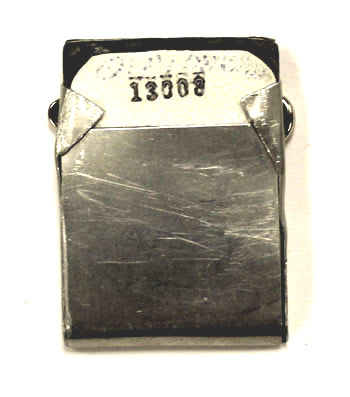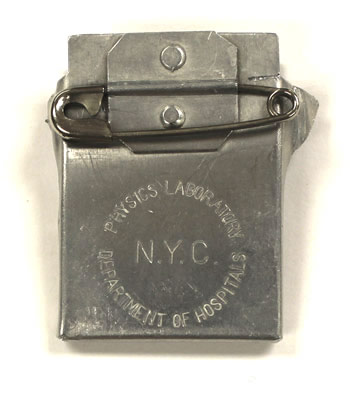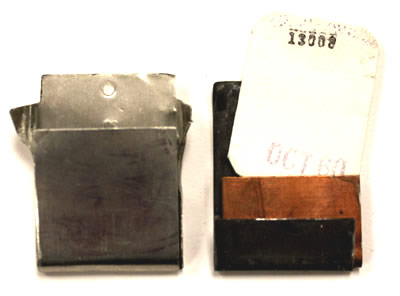NYC Department of Hospitals Film Badge (ca. 1930s, 1940s)


The first "true" film badge was designed in the early 1930s by Carl Braestrup for use in the New York City Department of Hospitals. While it is possible that the example in the ORAU collection is one of these, I haven't been able to confirm that this is the case.
The film in our example is Kodak ultra-speed dental film (backed by 0.5 mm of lead).
The case is aluminum.
The filters (0.5 mm thick) are lead and copper.
Size: 1.25” x 1.75”
Kindly donated by Mike O’Riordan.

The fact that the film in our badge has “OCT 60” stamped on it means that it is reasonably safe to assume that the badge was manufactured sometime before 1960.
That our badge, constructed from a single folded piece of aluminum, was undoubtedly produced in-house at the Department of Hospitals Physics Laboratory suggests that the design, if not the actual badge, dates from before 1950. The reason for saying so is that inexpensive machine-made film badges were commercially available by the late 1940s.
That the materials used for our badge (i.e., the aluminum case, copper and lead filters) match those of the badges described by Braestrup in 1942 (Radiology. Vol. 38, No. 2: pp. 207-216) suggests that our badge might be identical in other respects to the badges from the early 1940s.
Could the badge featured here be an example of the first "true" film badge, in other words one of the original badges used in the New York City Hospital system during the 1930s? I guess the answer is maybe.
The NYC Department of Hospitals Badge and the Badges used in the Manhattan Project
Quoting Carl Braestrup's obituary in the New York Times (August 9, 1985):
“He developed various devices to measure the dose and type of radiation exposure, including the film badge worn by radiation workers that was later adopted for use by the Atomic Energy Commission.”
Lauriston Taylor made a point of discussing the badge in an interview he conducted with Braestrup for the Bureau of Radiological Health. Quoting Taylor:
“This was the first film badge for measuring stray radiation around x-ray plants. Now this particular badge was one that could identify the energy of the radiation that was involved as well as the dose. And it was a forerunner of what has now become a very standard practice.”
In the interview Braestrup indicated that it was worn by all the radiation workers in the New York City Hospital system starting in the early 1930s, but that he had no idea that the technique would become as widespread as it did. He also said that he was contacted by Manhattan District personnel at the start of WW II and asked if he had patented the design for the badge—something he had not done. As a result, the mass produced film badges used in the Manhattan Project were based on Braestrup’s badge. Taylor smiled and commented to the effect that Braestrup would have become a rich man had he patented the device. See one of these Manhattan District badges.
Earliest Description of the NYC Department of Hospitals Film Badges
The earliest discussion concerning these badges that I am aware of can be found in a paper by Braestrup that appeared in Radiology ("X-ray Protection in Diagnostic Radiology" Radiology Vol. 38, No. 2: pp. 207-216. February 1942).
“An approximate yet satisfactory check may be obtained by means of dental films carried for a period of a month. While film stray radiation determinations are subject to numerous errors due to differences in film sensitivity, dark room procedure, ray quality [energy], etc., they are sufficiently dependable to indicate whether or not the more accurate ionization measurements are required. The test films should be compared, by means of a densitometer, with control films exposed to known fractions of a roentgen using similar ray quality.
The film tests have the advantage, also that they may give an indication of the ray quality [energy] if parts of the film are covered with different filter materials. A knowledge of the ray quality serves to indicate the origin of the stray radiation, whether it is due to radium, high voltage or low voltage X-rays.”
